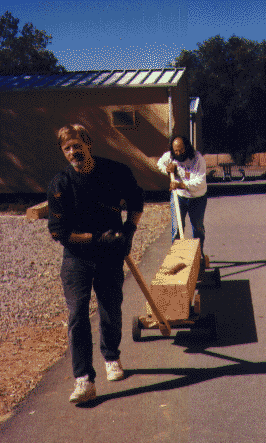How to make the beam carriers
During the project, we had to move almost 100 beams around, each one numerous times. These were 8-14 foot long 10x10" and 10x12". This is what made it possible:

|
The carrier on the right is turned upside down,
to show the 'heel'. This ensures that the platform
is horizontal when the handle lays on the ground,
as in the one on the left.
|
At the hardware store, find some appropriate wheels. I found 7 3/4" diameter plastic wheels with solid rubber tires. Avoid non-solid rubber wheels as the weight of your load will crush them. My wheels have 1/2" diameter axle holes, which just match the 1/2" steel rod I could buy, in 4' lengths, which makes 2 axles. The axle rests in a shallow groove cut into a short length of 4x4, and is held in place with a few nails. The 4x4 is the length of the axle minus the thickness of the wheels and a pair of washers. With a hand drill I drilled
a 3/16" hole into the ends of the the axles. I filed down the end of a piece of 3/16" threaded rod so that it fit snugly into the hole, where it will remain if the fit is tight enough so that is has to be hammered home. Slip the wheels on, and a big washer and 3/16" nut will hold everything in place. A 15x15" piece of plywood is screwed on top of the 4x4.
The swiveling top is another piece of plywood with 2x4 edges, spaced to take the widest beam plus a few fingers' width. Between the bottom square and the swiveling top is a 12" lazy suzan bearing; you'll need a 1" hole in the bottom plywood piece to install the last screws. Note that the swiveling piece now clears the wheels. A triangular piece of plywood is attached to the bottom part with strap hinges.
A pair of long handles is cut from an 8' 2x4, cut into 2 identical pieces according to the drawing. A 'heel' block is cut from a piece of 2x2 and attached to the underside of the handle. The heel thickness should be adjusted such that that the platform is horizontal when the handle rests on the ground.
When moving beams around, both ends can swivel, giving you great manouevrability, so you can work in very tight spots, and can get them right up to where they need to be lifted.

back


